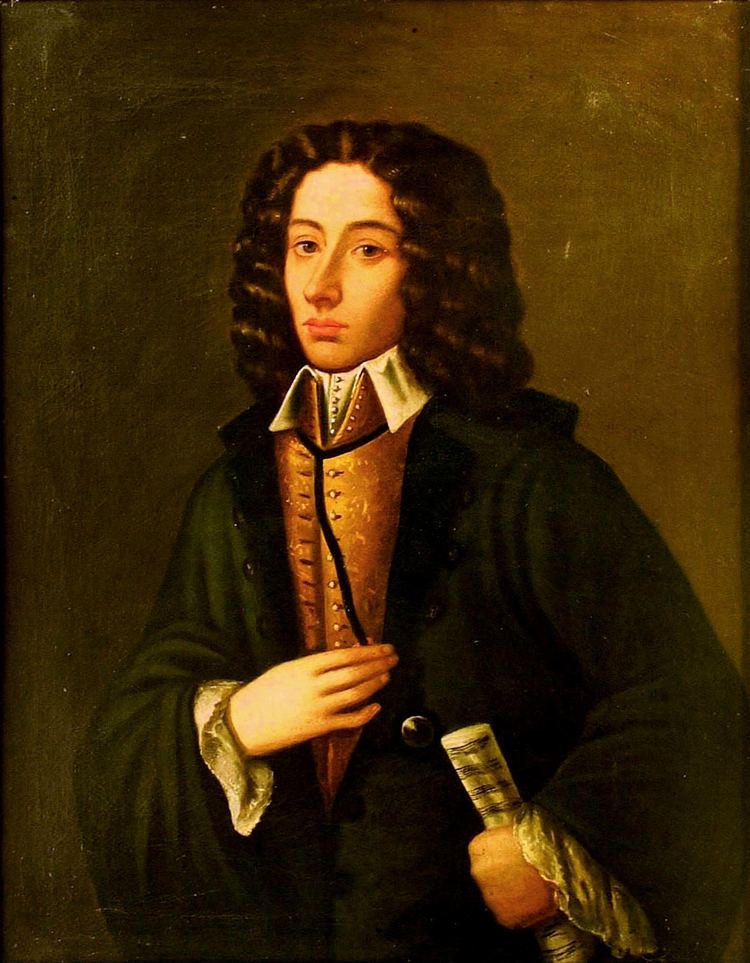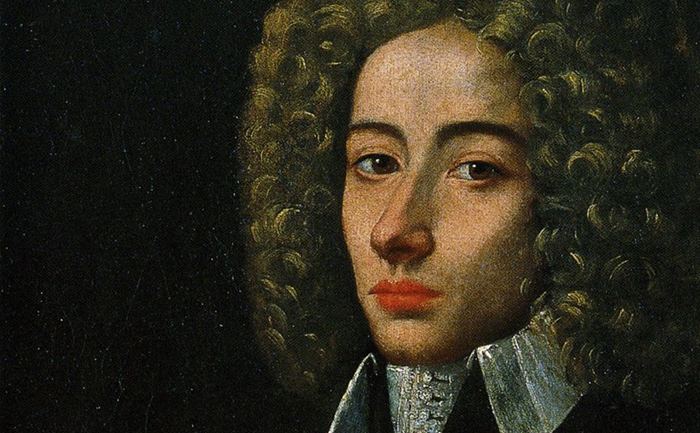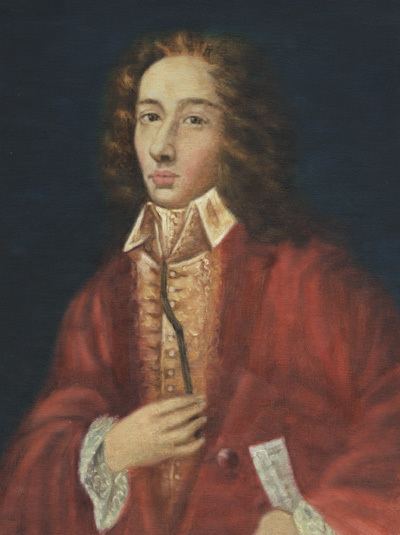Name Giovanni Pergolesi | Role Composer | |
 | ||
Died March 16, 1736, Pozzuoli, Italy Parents Francesco Andrea Draghi, Anna Vittoria Giorgi Compositions Stabat Mater, Stabat Mater, La serva padrona, La serva padrona, Lo frate 'nnamorato, Lo frate 'nnamorato, Adriano in Siria, Adriano in Siria, Il prigionier superbo, Il prigionier superbo, La olimpiada, La olimpiada, Stabat mater for soprano - alto - strings and basso continuo: VIII Duo: Fac - ut ardeat cor meum, Stabat mater for soprano - alto - strings and basso continuo: VIII Duo: Fac - ut ardeat cor meum, Violin Concerto in B-flat major: I Allegro, Violin Concerto in B-flat major: I Allegro, Motette - BWV 1083 "Tilge - Hochster - meine Sunden": Versus 10 (Sopran - Alt) "Las mich Freud und Wonne spuren", Motette - BWV 1083 "Tilge - Hochster - meine Sunden": Versus 10 (Sopran - Alt) "Las mich Freud und Wonne spuren", Stabat mater for soprano - alto - strings and basso continuo: II Aria (soprano): Cujus animam gementem, Stabat mater for soprano - alto - strings and basso continuo: II Aria (soprano): Cujus animam gementem, Motette - BWV 1083 "Tilge - Hochster - meine Sunden": Versus 7 (Sopran - Alt) "Sieh! ich bin in Sund empfangen", Motette - BWV 1083 "Tilge - Hochster - meine Sunden": Versus 7 (Sopran - Alt) "Sieh! ich bin in Sund empfangen", Concerto for Flute - Strings and Continuo in G major: II Adagio, Concerto for Flute - Strings and Continuo in G major: II Adagio, Septem verba a Christo in cruce moriente prolata: Verbum IV: Deus meus - deus meus - ut quid dereliquisti me? (Mark 15:34): Aria "Afflicte - derelicte" (Anima [alto]), Septem verba a Christo in cruce moriente prolata: Verbum IV: Deus meus - deus meus - ut quid dereliquisti me? (Mark 15:34): Aria "Afflicte - derelicte" (Anima [alto]), Stabat mater for soprano - alto - strings and basso continuo: X Aria (alto): Fac - ut protem Christi mortem, Stabat mater for soprano - alto - strings and basso continuo: X Aria (alto): Fac - ut protem Christi mortem, Motette - BWV 1083 "Tilge - Hochster - meine Sunden": Versus 5 & 6 (Sopran - Alt) "Wer wird seine Schuld verneinen", Motette - BWV 1083 "Tilge - Hochster - meine Sunden": Versus 5 & 6 (Sopran - Alt) "Wer wird seine Schuld verneinen", Confiteor tibi Domine: IV Coro "Redemptionem misit", Confiteor tibi Domine: IV Coro "Redemptionem misit", Stabat mater for soprano - alto - strings and basso continuo: XIII Amen, Stabat mater for soprano - alto - strings and basso continuo: XIII Amen, Stabat mater for soprano - alto - strings and basso continuo: VI Aria: Vidit suum dulcem natum, Stabat mater for soprano - alto - strings and basso continuo: VI Aria: Vidit suum dulcem natum, Confiteor tibi Domine: II Soprano solo "Confessio", Confiteor tibi Domine: II Soprano solo "Confessio", Septem verba a Christo in cruce moriente prolata: Verbum VII: Pater - in manus tuas commendo spiritum meum (Luke 23:44-46): Aria "Quid ultra peto vivere" (Anima [tenor]), Septem verba a Christo in cruce moriente prolata: Verbum VII: Pater - in manus tuas commendo spiritum meum (Luke 23:44-46): Aria "Quid ultra peto vivere" (Anima [tenor]), Septem verba a Christo in cruce moriente prolata: Verbum II: Amen dico tibi: hodie mecum eris in Paradiso (Luke 25:43): Aria "Latronem hunc aspicite" (Christus [tenor]), Septem verba a Christo in cruce moriente prolata: Verbum II: Amen dico tibi: hodie mecum eris in Paradiso (Luke 25:43): Aria "Latronem hunc aspicite" (Christus [tenor]), Motette - BWV 1083 "Tilge - Hochster - meine Sunden": Versus 17 & 18 (Sopran - Alt) "Denn du willst kein Opfer haben", Motette - BWV 1083 "Tilge - Hochster - meine Sunden": Versus 17 & 18 (Sopran - Alt) "Denn du willst kein Opfer haben", Septem verba a Christo in cruce moriente prolata: Verbum I: Pater - dimitte illis: non enim sciunt qui faciunt (Luke 23:34): Aria "En doceo diligere" (Christus [bass]), Septem verba a Christo in cruce moriente prolata: Verbum I: Pater - dimitte illis: non enim sciunt qui faciunt (Luke 23:34): Aria "En doceo diligere" (Christus [bass]), Septem verba a Christo in cruce moriente prolata: Verbum VII: Pater - in manus tuas commendo spiritum meum (Luke 23:44-46): Aria "In tuum - Pater - gremium" (Christus [bass]), Septem verba a Christo in cruce moriente prolata: Verbum VII: Pater - in manus tuas commendo spiritum meum (Luke 23:44-46): Aria "In tuum - Pater - gremium" (Christus [bass]), Aquiles en Esciro, Aquiles en Esciro, Stabat mater for soprano - alto - strings and basso continuo: XII Duo: Quando corpus morietur - Amen, Stabat mater for soprano - alto - strings and basso continuo: XII Duo: Quando corpus morietur - Amen, Motette - BWV 1083 "Tilge - Hochster - meine Sunden": XIV (Sopran - Alt) "Amen", Motette - BWV 1083 "Tilge - Hochster - meine Sunden": XIV (Sopran - Alt) "Amen", Stabat mater for soprano - alto - strings and basso continuo: VII Aria (alto): Eja - mater - fons amoris, Stabat mater for soprano - alto - strings and basso continuo: VII Aria (alto): Eja - mater - fons amoris, Motette - BWV 1083 "Tilge - Hochster - meine Sunden": Versus 9 (Alt) "Wasche mich doch rein von Sunden", Motette - BWV 1083 "Tilge - Hochster - meine Sunden": Versus 9 (Alt) "Wasche mich doch rein von Sunden", Sicilienne, Sicilienne, Concerto for Flute - Strings and Continuo in G major: III Allegro spiritoso, Concerto for Flute - Strings and Continuo in G major: III Allegro spiritoso, Stabat mater for soprano - alto - strings and basso continuo: XI Duo: Inflammatus et accensus, Stabat mater for soprano - alto - strings and basso continuo: XI Duo: Inflammatus et accensus, Confiteor tibi Domine: VIII Coro "Sicut erat", Confiteor tibi Domine: VIII Coro "Sicut erat", Stabat mater for soprano - alto - strings and basso continuo: IV Aria (alto): Quae moerebat et dolebat, Stabat mater for soprano - alto - strings and basso continuo: IV Aria (alto): Quae moerebat et dolebat, Septem verba a Christo in cruce moriente prolata: Verbum VI: Consummatum est (John 19:29): Aria "Sic consummasti omnia" (Anima [soprano]), Septem verba a Christo in cruce moriente prolata: Verbum VI: Consummatum est (John 19:29): Aria "Sic consummasti omnia" (Anima [soprano]), Septem verba a Christo in cruce moriente prolata: Verbum III: Mulier ecce filius tuus (John 19:26): Recitativo "Servator optime" (Anima [soprano]), Septem verba a Christo in cruce moriente prolata: Verbum III: Mulier ecce filius tuus (John 19:26): Recitativo "Servator optime" (Anima [soprano]), Confiteor tibi Domine: I Coro "Confitebor", Confiteor tibi Domine: I Coro "Confitebor", Salve Regina a due voci in C minor, Salve Regina a due voci in C minor, Septem verba a Christo in cruce moriente prolata: Verbum V: Sitio (John 19:28): Aria "O vos omnes - qui transitis" (Christus [bass]), Septem verba a Christo in cruce moriente prolata: Verbum V: Sitio (John 19:28): Aria "O vos omnes - qui transitis" (Christus [bass]), Confiteor tibi Domine: VI Alto solo "Intellectus bonus", Confiteor tibi Domine: VI Alto solo "Intellectus bonus", Stabat mater for soprano - alto - strings and basso continuo: XII Duo: Quando corpus morietur, Stabat mater for soprano - alto - strings and basso continuo: XII Duo: Quando corpus morietur, Motette - BWV 1083 "Tilge - Hochster - meine Sunden": Versus 16 (Alt) "Offne Lippen - Mund und Seele", Motette - BWV 1083 "Tilge - Hochster - meine Sunden": Versus 16 (Alt) "Offne Lippen - Mund und Seele", Motette - BWV 1083 "Tilge - Hochster - meine Sunden": Versus 1 (Sopran - Alt) "Tilge - Hochster meine Sunden", Motette - BWV 1083 "Tilge - Hochster - meine Sunden": Versus 1 (Sopran - Alt) "Tilge - Hochster meine Sunden", Septem verba a Christo in cruce moriente prolata: Verbum III: Mulier ecce filius tuus (John 19:26): Recitativo "Quo me - amor?" (Christus [bass]), Septem verba a Christo in cruce moriente prolata: Verbum III: Mulier ecce filius tuus (John 19:26): Recitativo "Quo me - amor?" (Christus [bass]), Stabat mater for soprano - alto - strings and basso continuo: III Duo: O quam tristis et afflicta, Stabat mater for soprano - alto - strings and basso continuo: III Duo: O quam tristis et afflicta, Confiteor tibi Domine: VII Coro "Gloria Patri", Confiteor tibi Domine: VII Coro "Gloria Patri", Septem verba a Christo in cruce moriente prolata: Verbum VI: Consummatum est (John 19:29): Aria "Huc advolate mortales" (Christus [bass]), Septem verba a Christo in cruce moriente prolata: Verbum VI: Consummatum est (John 19:29): Aria "Huc advolate mortales" (Christus [bass]), Motette - BWV 1083 "Tilge - Hochster - meine Sunden": Versus 8 (Sopran) "Sieh - du willst die Wahrheit haben", Motette - BWV 1083 "Tilge - Hochster - meine Sunden": Versus 8 (Sopran) "Sieh - du willst die Wahrheit haben", Stabat mater for soprano - alto - strings and basso continuo: I Duo: Stabat mater dolorosa, Stabat mater for soprano - alto - strings and basso continuo: I Duo: Stabat mater dolorosa, Violin Concerto in B-flat major: III Allegro, Violin Concerto in B-flat major: III Allegro, Violin Concerto in B-flat major: II Largo, Violin Concerto in B-flat major: II Largo Books La serva padrona, The Magnificat: (Vocal Sc, Stabat mater : fur Sopran - A, Contralto Soli - SA & Orchestra, Stabat Mater | ||
Giovanni battista pergolesi 1710 1736 gloria patri
Giovanni Battista Draghi ([dʒoˈvanni batˈtista ˈdraːɡi]) (4 January 1710 – 16 March 1736), best known as Pergolesi ([perɡoˈleːzi]) or Giovanni Battista Pergolesi, was an Italian composer, violinist and organist.
Contents
- Giovanni battista pergolesi 1710 1736 gloria patri
- Giovanni Battista Pergolesi Stabat Mater
- Biography
- Pergolesis works on screen
- References

Giovanni Battista Pergolesi - Stabat Mater
Biography

Born in Jesi in what is now the Province of Ancona (but was then the Papal States), he was commonly given the nickname "Pergolesi", a demonym indicating in Italian the residents of Pergola, Marche, the birthplace of his ancestors. He studied music in Iesi under a local musician, Francesco Santini, before going to Naples in 1725, where he studied under Gaetano Greco and Francesco Feo among others. He spent most of his brief life working for aristocratic patrons like the Colonna principe di Stigliano, and duca Marzio IV Maddaloni Carafa.

Pergolesi was one of the most important early composers of opera buffa (comic opera). His opera seria, Il prigionier superbo, contained the two act buffa intermezzo, La serva padrona (The Servant Mistress, 28 August 1733), which became a very popular work in its own right. When it was performed in Paris in 1752, it prompted the so-called Querelle des Bouffons ("quarrel of the comic actors") between supporters of serious French opera by the likes of Jean-Baptiste Lully and Jean-Philippe Rameau and supporters of new Italian comic opera. Pergolesi was held up as a model of the Italian style during this quarrel, which divided Paris's musical community for two years.

Among Pergolesi's other operatic works are his first opera La conversione e morte di San Guglielmo (1731), Lo frate 'nnamorato (The brother in love, 1732, to a text in the Neapolitan language), L'Olimpiade (31 January 1735) and Il Flaminio (1735). All his operas were premiered in Naples, apart from L'Olimpiade, which was first given in Rome.
Pergolesi also wrote sacred music, including a Mass in F and two Salve Regina settings. It is his Stabat Mater (1736), however, for soprano, alto, string orchestra and basso continuo, which is his best-known sacred work. It was commissioned by the Confraternita dei Cavalieri di San Luigi di Palazzo who presented an annual Good Friday meditation in honor of the Virgin Mary. Pergolesi's work replaced one composed by Alessandro Scarlatti only nine years before, but which was already perceived as "old-fashioned," so rapidly had public tastes changed.
While classical in scope, the opening section of the setting demonstrates Pergolesi's mastery of the Italian baroque durezze e ligature style, characterized by numerous suspensions over a faster, conjunct bassline. The work remained popular, becoming the most frequently printed work of the 18th century, and being arranged by a number of other composers, including Johann Sebastian Bach, who used it as the basis for his cantata Tilge, Hochster, meine Sunden (Root out my sins, Highest One), BWV 1083.
Pergolesi wrote a number of secular instrumental works, including a violin sonata and a violin concerto. A considerable number of instrumental and sacred works once attributed to Pergolesi have since been shown to be misattributed. Much of Igor Stravinsky's ballet Pulcinella, which ostensibly reworks pieces by Pergolesi, is actually based on works by other composers, especially Domenico Gallo. The Concerti Armonici are now known to have been composed by Unico Wilhelm van Wassenaer. Many colorful anecdotes related by Pergolesi's 19th-century biographer, Francesco Florimo, were later revealed as fabrication, though they furnished material for two nineteenth-century operas broadly based on Pergolesi's career.
Giovanni Battista Pergolesi died on March 16, 1736 at the age of 26 in Pozzuoli from tuberculosis and was buried at the Franciscan monastery one day later.
Pergolesi's works on screen
Pergolesi's Salve Regina is a highlighted performance in the movie Farinelli (1994), in which Farinelli also performs Stabat Mater Dolorosa in the only duet. The first and last parts of Pergolesi's Stabat Mater were used in the soundtrack of the movie Jesus de Montreal (1989); the third part ("Quis est homo") was used in the soundtrack of the movie Smilla's Sense of Snow (1997); the last part was also used in the movie Amadeus (1984) and in the movie The Mirror (1975) by Andrei Tarkovsky. The film Cactus (1986) by the Australian director Paul Cox also features Pergolesi's Stabat Mater on the soundtrack.
